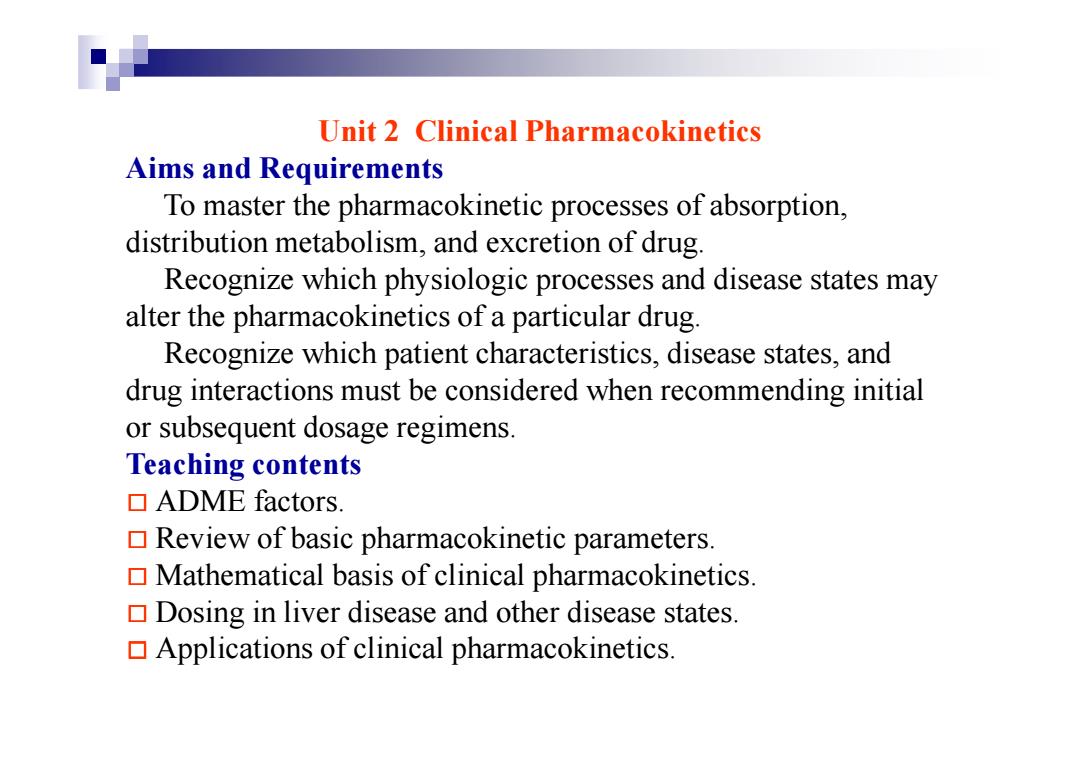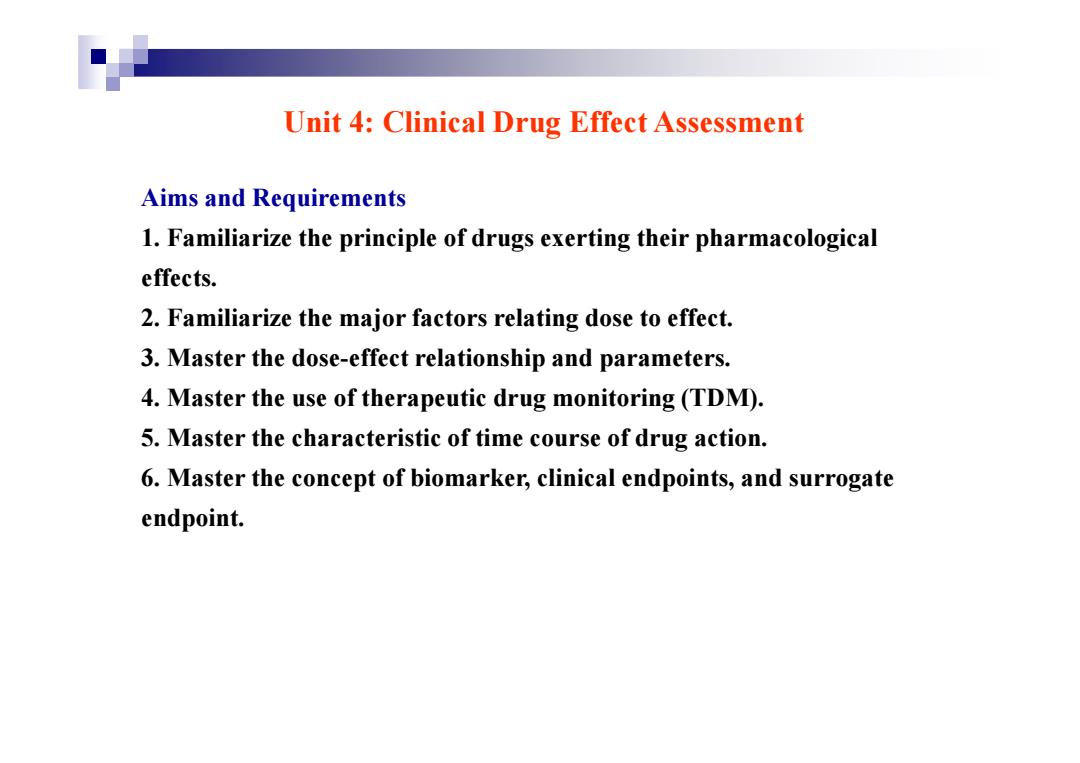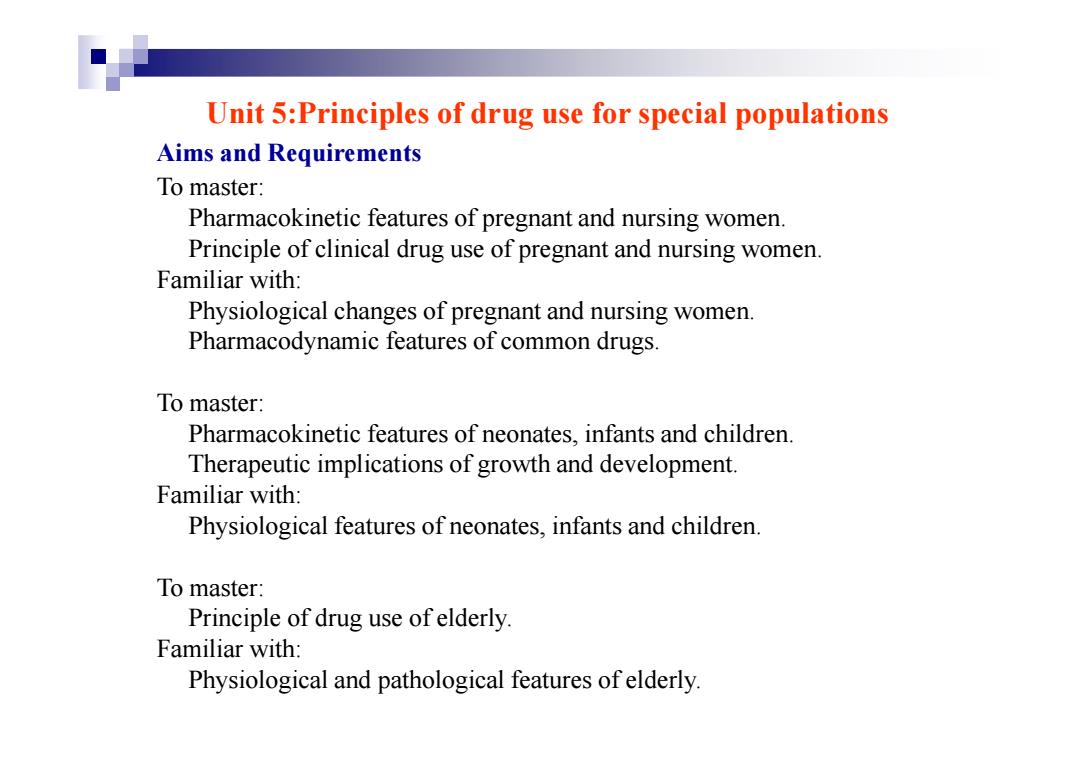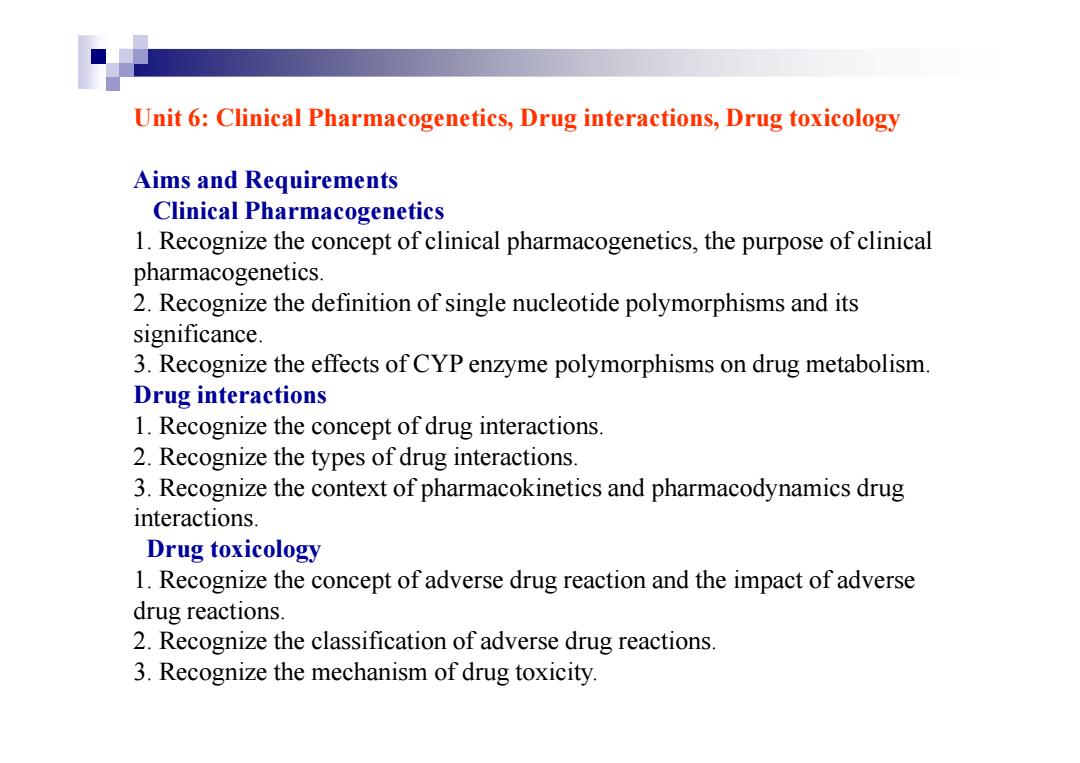
Unit 2 Clinical Pharmacokinetics Aims and Requirements To master the pharmacokinetic processes of absorption, distribution metabolism,and excretion of drug. Recognize which physiologic processes and disease states may alter the pharmacokinetics of a particular drug. Recognize which patient characteristics,disease states,and drug interactions must be considered when recommending initial or subsequent dosage regimens. Teaching contents ADME factors. Review of basic pharmacokinetic parameters. Mathematical basis of clinical pharmacokinetics. Dosing in liver disease and other disease states. Applications of clinical pharmacokinetics
Unit 2 Clinical Pharmacokinetics Aims and Requirements To master the pharmacokinetic processes of absorption, distribution metabolism, and excretion of drug. Recognize which physiologic processes and disease states may alter the pharmacokinetics of a particular drug. Recognize which patient characteristics, disease states, and drug interactions must be considered when recommending initial or subsequent dosage regimens. Teaching contents □ ADME factors. □ Review of basic pharmacokinetic parameters. □ Mathematical basis of clinical pharmacokinetics. □ Dosing in liver disease and other disease states. □ Applications of clinical pharmacokinetics

Unit 3:Drug Discovery Development Aims and Requirements 1.To know of the global profile of new drug development. 2.To master the components of preclinical drug development. 3.To know of animal models for human tumors. 4.To master the definition of GCP. 5.To master the determination of minimum first dose. 6.To recognize the purpose and significance of clinical trials. 7.To recognize the purpose and significance of human bioavailability test. 8.To know of the definition of drugs,new drug and bioavailability. 9.To know of the guidelines of drugs therapy in clinical practice
Unit 3:Drug Discovery & Development Aims and Requirements 1. To know of the global profile of new drug development. 2. To master the components of preclinical drug development. 3. To know of animal models for human tumors. 4. To master the definition of GCP. 5. To master the determination of minimum first dose. 6. To recognize the purpose and significance of clinical trials. 7. To recognize the purpose and significance of human bioavailability test. 8. To know of the definition of drugs, new drug and bioavailability. 9. To know of the guidelines of drugs therapy in clinical practice

Unit 4:Clinical Drug Effect Assessment Aims and Requirements 1.Familiarize the principle of drugs exerting their pharmacological effects. 2.Familiarize the major factors relating dose to effect. 3.Master the dose-effect relationship and parameters. 4.Master the use of therapeutic drug monitoring (TDM). 5.Master the characteristic of time course of drug action. 6.Master the concept of biomarker,clinical endpoints,and surrogate endpoint
Unit 4: Clinical Drug Effect Assessment Aims and Requirements 1. Familiarize the principle of drugs exerting their pharmacological effects. 2. Familiarize the major factors relating dose to effect. 3. Master the dose-effect relationship and parameters. 4. Master the use of therapeutic drug monitoring (TDM). 5. Master the characteristic of time course of drug action. 6. Master the concept of biomarker, clinical endpoints, and surrogate endpoint

Unit 5:Principles of drug use for special populations Aims and Requirements To master: Pharmacokinetic features of pregnant and nursing women. Principle of clinical drug use of pregnant and nursing women. Familiar with: Physiological changes of pregnant and nursing women. Pharmacodynamic features of common drugs. To master: Pharmacokinetic features of neonates,infants and children. Therapeutic implications of growth and development. Familiar with: Physiological features of neonates,infants and children. To master: Principle of drug use of elderly. Familiar with: Physiological and pathological features of elderly
Unit 5:Principles of drug use for special populations Aims and Requirements To master: Pharmacokinetic features of pregnant and nursing women. Principle of clinical drug use of pregnant and nursing women. Familiar with: Physiological changes of pregnant and nursing women. Pharmacodynamic features of common drugs. To master: Pharmacokinetic features of neonates, infants and children. Therapeutic implications of growth and development. Familiar with: Physiological features of neonates, infants and children. To master: Principle of drug use of elderly. Familiar with: Physiological and pathological features of elderly

Unit 6:Clinical Pharmacogenetics,Drug interactions,Drug toxicology Aims and Requirements Clinical Pharmacogenetics 1.Recognize the concept of clinical pharmacogenetics,the purpose of clinical pharmacogenetics. 2.Recognize the definition of single nucleotide polymorphisms and its significance. 3.Recognize the effects of CYP enzyme polymorphisms on drug metabolism. Drug interactions 1.Recognize the concept of drug interactions. 2.Recognize the types of drug interactions 3.Recognize the context of pharmacokinetics and pharmacodynamics drug interactions. Drug toxicology 1.Recognize the concept of adverse drug reaction and the impact of adverse drug reactions. 2.Recognize the classification of adverse drug reactions. 3.Recognize the mechanism of drug toxicity
Unit 6: Clinical Pharmacogenetics, Drug interactions, Drug toxicology Aims and Requirements Clinical Pharmacogenetics 1. Recognize the concept of clinical pharmacogenetics, the purpose of clinical pharmacogenetics. 2. Recognize the definition of single nucleotide polymorphisms and its significance. 3. Recognize the effects of CYP enzyme polymorphisms on drug metabolism. Drug interactions 1. Recognize the concept of drug interactions. 2. Recognize the types of drug interactions. 3. Recognize the context of pharmacokinetics and pharmacodynamics drug interactions. Drug toxicology 1. Recognize the concept of adverse drug reaction and the impact of adverse drug reactions. 2. Recognize the classification of adverse drug reactions. 3. Recognize the mechanism of drug toxicity